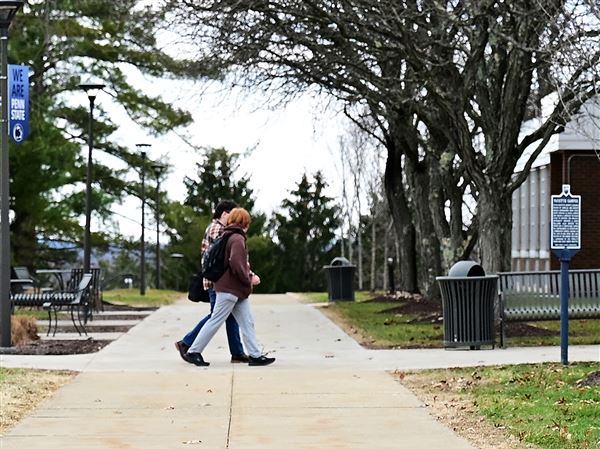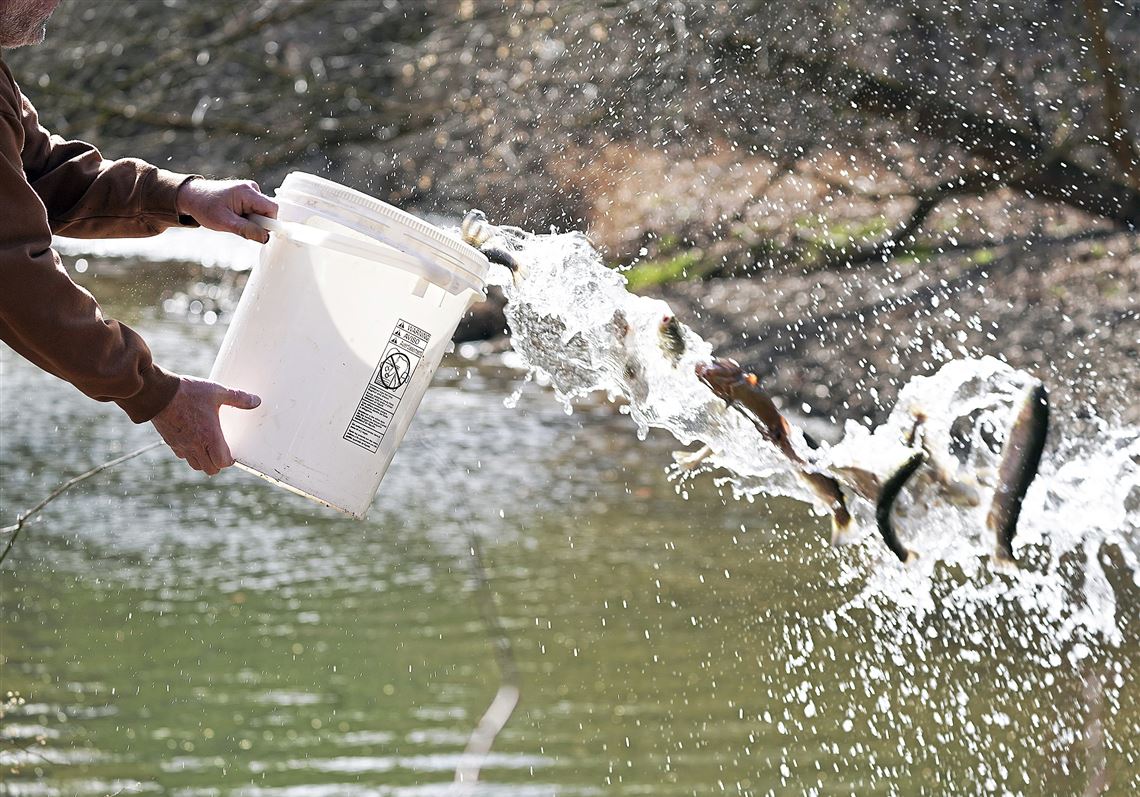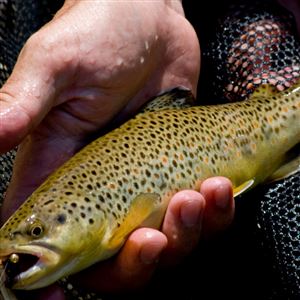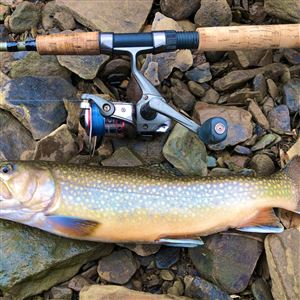MILESBURG, Pa. — On a chilly March morning, beautifully tinted rainbow trout and their bright golden-rainbow cousins are netted from a truck’s holding tank and poured from five-gallon plastic buckets into a Centre County stream.
In the low clear water of Bald Eagle Creek, vague streaks of silver and yellow disperse in all directions as hatchery workers carry the empty buckets back to the truck parked off the road behind the old Curtain Village iron works and national historic district, about 20 miles northeast of State College.
It was a routine preseason trout stocking for the Pennsylvania Fish and Boat Commission, one stop among 1,900 road trips moving a fleet of 45 trucks some 360,000 miles across the commonwealth to stock creeks, rivers and lakes with 4.2 million hatchery-raised trout. Stocking started in late February.
Most of the fish will be in the water before about 900,000 licensed anglers and an unknown number of children plop their lines into the water at 8 a.m. Saturday, the opening moment of the statewide trout season.
This is the third year that the Bald Eagle Creek stockings, and those at a dozen smaller streams, have occurred under increased scrutiny. Fish and Boat executives are watching, as are many trout anglers, as the hatchery trout are stocked over a naturally reproducing population of wild trout.
For decades, that practice has been banned by the agency. The overstocking is an aquatic experiment that might reverse decades of Fish and Boat policy forbidding the stocking of hatchery trout over wild trout for reasons including competition for food and the spread of parasites and disease among delicate wild brook trout.
The brightly speckled brook trout is Pennsylvania’s state fish. With the exception of the struggling lake trout in Lake Erie, Salvelinus fontinalis is the only trout species native to the state. Larger brown trout were imported from Europe and rainbow trout were brought from the nation’s Northwest by sporting groups beginning in the late 1800s. Now naturalized, many browns and rainbows reproduce in the wild but not in the numbers or locations necessary to satisfy the interests of the state’s anglers.
Recognizing the value of healthy, high-quality outdoor recreation and the psychological incentives connecting fishing with water quality, Pennsylvania began stocking trout in 1898.
With more stream miles than any state but Alaska and some 130 lakes totaling 7,083 acres suitable for trout, Pennsylvania has one of the most ambitious trout stocking programs in the United States. In addition to warm-water hatcheries where other species are cultured, eight cold-water trout hatcheries are operated by Fish and Boat. For the last 10 years, those hatcheries have produced 3.2 million mature trout averaging 11 inches for annual stocking. Cooperative nurseries, mostly run by volunteer sporting groups, produce another 1 million trout for the state stocking program.
The Pennsylvania Fish and Boat Commission is a semi-autonomous agency of the state’s executive branch operating on a $55 million annual budget. The trout program’s annual operating cost to the agency is about $10 million.
Fish and Boat receives no funding from Pennsylvania taxpayers. It is supported by angler dollars including license and permit fees and a federal excise tax on fishing gear and boat fuel, which is funneled back to the state by the U.S. Fish and Wildlife Service.
In a 2021 survey, the American Sportfishing Association, a trade group, reported that recreational fishing in Pennsylvania contributed $627.2 million to the state economy and supported 7,110 jobs. The economic value of trout fishing wasn’t categorized, but 7 of 10 Pennsylvania anglers buy both a fishing license ($25.47 for adult residents) and permit required to fish for trout ($12.47). Fish and Boat estimates that 70% of all fishing expenditures in Pennsylvania are spent on trout fishing.
Determining how many stocked trout go where is a complicated process. Some waters suitable for trout do not receive stocking. For many years fishing has been permitted in waters designated Class A containing a significant biomass of wild reproducing trout. A conservation policy held that no overstocking of hatchery trout was permitted in Class A waters.
The trout overstocking experiment was started when Fish and Boat biologists surveying a heavily stocked section of Bald Eagle Creek found a thriving population of wild brown trout coexisting in the same waters as the hatchery-raised rainbows. That wasn’t supposed to happen.
To find out why they were there, stocking has continued at the Bald Eagle section and the frequency of surveying was increased. Commissioners created a new regulatory category: Stocked Trout Waters, Class A Wild Trout Stream.
When the experiment began, David Nihart, Fish and Boat division of fisheries management chief, said research found that on the Bald Eagle stretch from Milesburg to Sayers Lake, almost 30% of angler use happens on opening weekend. Most of the stocked trout are quickly harvested, and in summer the waters are dominated by wild brown trout. Similar characteristics or histories apply to a dozen additional streams or stream sections in Centre, Clinton, Mifflin, Lehigh, Northampton, Carbon and Bedford counties, where the odd regulatory category was also applied.
In those waters, only rainbow trout are stocked in what is now known to be wild brown trout waters. Rainbows and brown trout cannot successfully mate, so Nihart said the risk of accidentally creating a population of genetically weak wild trout is very low. And with the varieties of trout dominating at different times, there is likely to be little competition for food.
If the stocking experiment confirms that hatchery trout and wild trout can indeed coexist, he said, those waters could support a two-tier fishery where anglers seeking stocked trout can harvest fish in the spring and spin and fly fishing anglers can tempt wild trout in the summer.
Nihart said more discussion about the overstocking experiment was inappropriate until it is evaluated by commissioners and a policy is adopted.
“They’re missing the point,” said Lenny Lichvar, a former Fish and Boat commissioner from Western Pennsylvania and now president of the Pennsylvania council of Trout Unlimited, a national cold-water advocacy group. While on the commission, Lichvar voted against the overstocking experiment.
“My point wasn’t the genetic ramifications or even competition for food,” he said. “Stocking hatchery-raised trout where there are already trout is a waste of an expensive resource.”
Lichvar said the cost of the stocking program fluctuates yearly and he didn’t have current figures, but raising and stocking an individual adult trout is upwards of about $3.25.
“Multiply that by 4.2 million. That’s what Pennsylvania fishermen are paying for stocked trout,” he said. “Why put them where there are already trout that can be harvested without any negative conservation consequences? It doesn’t make sense.”
Nihart is expected to update commissioners on the overstocking experiment at a Fish and Boat meeting on fisheries and hatcheries issues. The virtual webinar meeting can be viewed at fishandboat.com at 10 a.m. April 5.
John Hayes: jhayes@post-gazette.com.
First Published: March 30, 2023, 9:30 a.m.
Updated: March 30, 2023, 10:03 a.m.





















